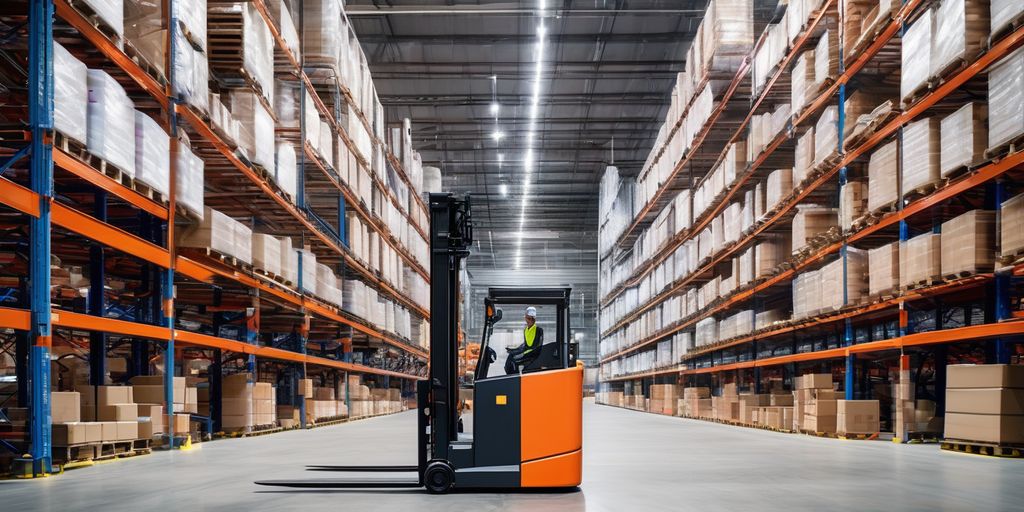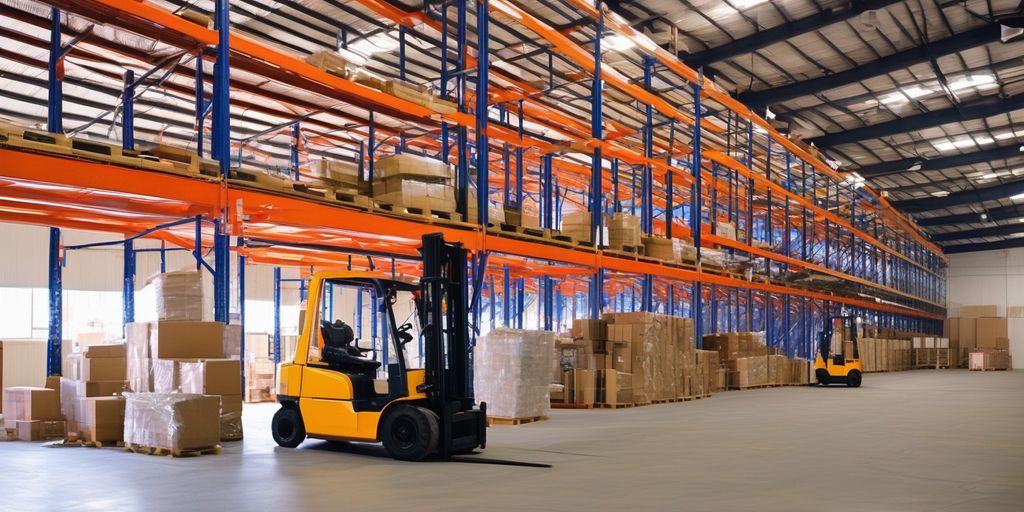In today’s fast-paced warehouse environments, the efficient and safe operation of forklifts is crucial for both employee well-being and overall business success. Forklift accidents can lead to injuries, damaged goods, and increased operating costs. Implementing effective safety measures not only protects your workforce but also contributes to cost savings through enhanced productivity and reduced equipment downtime. In this article, we will explore key strategies to improve forklift safety and minimize operating expenses in your warehouse.
Key Takeaways
- Comprehensive operator training programs are essential for ensuring that forklift operators are skilled and knowledgeable.
- Implementing safety checklists and regular inspections can prevent equipment failures and accidents.
- Utilizing smart technology for real-time monitoring and automated safety alerts enhances overall safety.
- Creating a culture of safety through regular meetings and rewarding safe behaviors encourages continuous improvement.
- Designing a safe warehouse layout with designated forklift lanes and pedestrian barriers reduces the risk of accidents.
Comprehensive Operator Training Programs

Investing in thorough forklift training programs for operators is the first step toward a safer and more productive warehouse. Properly trained operators are more adept at maneuvering forklifts in tight spaces, handling loads securely, and understanding the importance of safety protocols. Regular refresher courses can keep operators updated on the latest safety guidelines and best practices.
Implementing Safety Checklists and Inspections

Ensuring the safety of forklift operations begins with thorough and consistent inspections. Regular inspection is crucial for safety and helps in identifying potential hazards before they lead to accidents. Here are some key strategies to implement effective safety checklists and inspections:
Daily Equipment Inspections
Conducting daily equipment inspections is essential for maintaining forklift safety. Operators should use a standard pre-use inspection checklist and take the time to walk around the machine, methodically checking all components. Document any items that need to be corrected and report any concerns that might affect safe operation. Remember to also inspect your worksite and the surrounding conditions.
Pre-Operation Checklists
Pre-operation checklists are a vital part of forklift safety. These checklists allow operators to conduct and record inspections before using forklift equipment. It lists the items to look into during the inspection, ensuring that nothing is overlooked. This practice helps in identifying any damage or defects that might impact safe operation.
Regular Maintenance Schedules
Regular maintenance schedules are necessary for identifying hazards and addressing them promptly. Schedule routine inspections of equipment, storage racks, and warehouse facilities to ensure health and safety compliance. Encourage employees to report safety concerns or hazards they encounter during their work shifts.
Ignoring warning signs leads to accidents. Proper maintenance enhances safety and prevents costly repairs.
Utilizing Smart Technology for Safety

Data Collection and Analysis
Data analytics play a crucial role in enhancing forklift safety. By analyzing patterns and frequencies of near-miss incidents, organizations can pinpoint specific areas in need of safety adjustments. This proactive approach allows for strategic decisions to improve worker protection and optimize traffic flow within the facility.
Real-Time Monitoring Systems
Real-time monitoring systems provide precise location data, enabling a proactive approach to forklift safety, especially in complex environments where visibility is limited. These systems can detect the presence of people or obstacles and, in some cases, automatically slow down or stop the forklift when a potential collision is detected.
Automated Safety Alerts
Technological solutions, such as collision detection systems, serve as an extra layer of protection. These systems can detect the presence of people or obstacles and automatically trigger safety alerts. This ensures that both operators and pedestrians are aware of potential hazards, significantly reducing the risk of accidents.
Integrating advanced solutions for forklift safety not only enhances operational efficiency but also ensures a safer working environment for all employees.
Creating a Culture of Safety

Creating a culture of safety is essential for maintaining a safe workplace environment. Encourage open communication between management and employees regarding safety issues and encourage active participation in safety awareness programs. Recognize and reward employees who demonstrate safe behaviors and actively contribute to maintaining a safe workplace.
Designing a Safe Warehouse Layout

Designing a safe warehouse layout is crucial for minimizing accidents and ensuring smooth operations. A well-thought-out layout not only enhances safety but also improves efficiency and productivity within the warehouse environment.
Enforcing Strict Safety Policies

Adherence to OSHA Guidelines
Ensuring compliance with OSHA guidelines is crucial for maintaining a safe workplace. These guidelines provide a framework for safe practices and help in minimizing risks associated with forklift operations. Employees must follow the safety policies to ensure safety in the workplace. This not only protects employees but also helps the business meet its compliance obligations.
Periodic Safety Evaluations
Conducting regular safety inspections is necessary for identifying hazards and addressing them promptly. Schedule routine inspections of equipment, storage racks, and warehouse facilities to ensure health and safety compliance. Encourage employees to report safety concerns or hazards they encounter during their work shifts.
Consequences for Policy Violations
Inform employees of the consequences of not following safety policies. Use safety equipment and limit the speed of forklift drivers. Have a transparent communication system and foster a safety culture. Take steps to enforce safety policies at every opportunity. Ensure employees know the consequences of violating safety guidelines and rules.
Put safety measures in place to protect employees. Inform them of the consequences of not following safety policies. Use safety equipment and limit the speed of forklift drivers. Have a transparent communication system and foster a safety culture.
Emergency Preparedness and Response

Creating a comprehensive emergency plan is crucial for ensuring the safety of all employees. These plans should cover various scenarios, including fires, chemical spills, and natural disasters. It's essential to ensure that all equipment, including forklifts, pallet jacks, and conveyor systems, is properly maintained and inspected regularly.
Regular safety drills help employees become familiar with emergency procedures and reduce panic during actual emergencies. Drills should be conducted for different types of emergencies to ensure preparedness across all scenarios.
Providing first aid training to employees can significantly reduce the severity of injuries during accidents. Training should include basic first aid techniques, CPR, and the use of automated external defibrillators (AEDs).
Conclusion
Reducing forklift accidents in the workplace is not just about adhering to regulations; it is about fostering a culture of safety that prioritizes the well-being of employees and the efficiency of operations. By implementing comprehensive training programs, enforcing strict safety policies, and utilizing advanced technologies, businesses can significantly minimize the risks associated with forklift operations. Regular safety audits, continuous education, and a proactive approach to identifying and mitigating hazards are essential components of a successful safety strategy. Ultimately, a safer workplace leads to enhanced productivity, reduced costs, and a more motivated workforce, making it a win-win situation for everyone involved.
Frequently Asked Questions
How can we efficiently reduce forklift accidents in a warehouse?
Several key measures can be implemented to reduce forklift accidents in a warehouse, including comprehensive operator training, implementing safety checklists, utilizing smart technology, and creating a culture of safety.
What are some effective strategies for improving forklift safety?
Effective strategies for improving forklift safety include comprehensive operator training and certification programs, ensuring only authorized personnel operate forklifts, implementing safety checklists and equipment inspections, using smart technology to collect and analyze safety data, and promoting a culture of safety.
Why is forklift safety important in a warehouse environment?
Forklift safety is crucial in a warehouse environment to protect employee well-being, prevent injuries, avoid damaged goods, and reduce operating costs through enhanced productivity and reduced equipment downtime.
What role does smart technology play in forklift safety?
Smart technology plays a significant role in forklift safety by enabling data collection and analysis, real-time monitoring systems, and automated safety alerts, which help in identifying and mitigating potential safety risks.
How can we create a culture of safety in the workplace?
Creating a culture of safety involves regular safety meetings, encouraging the reporting of near misses, rewarding safe behaviors, and consistently enforcing safety policies and guidelines.
What are the benefits of regular safety evaluations and drills?
Regular safety evaluations and drills help ensure that safety protocols are up-to-date, employees are well-prepared for emergencies, and any potential safety hazards are identified and addressed promptly.




Leave a comment
This site is protected by hCaptcha and the hCaptcha Privacy Policy and Terms of Service apply.